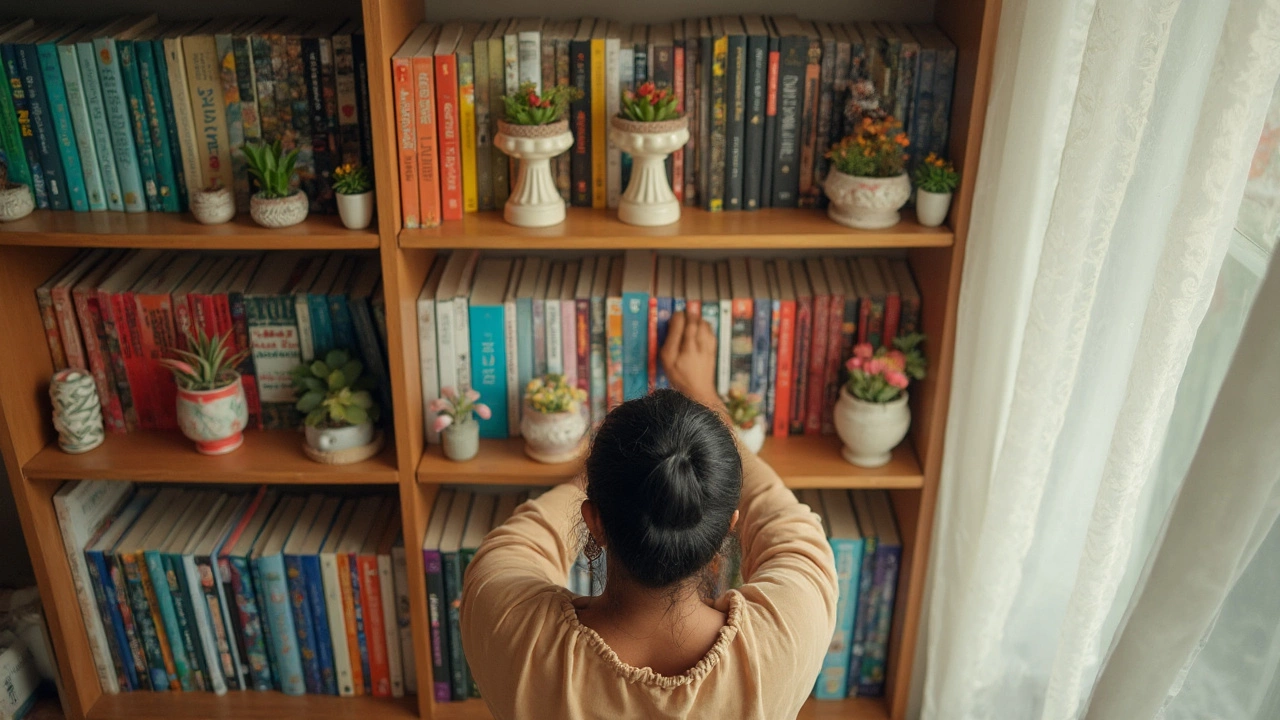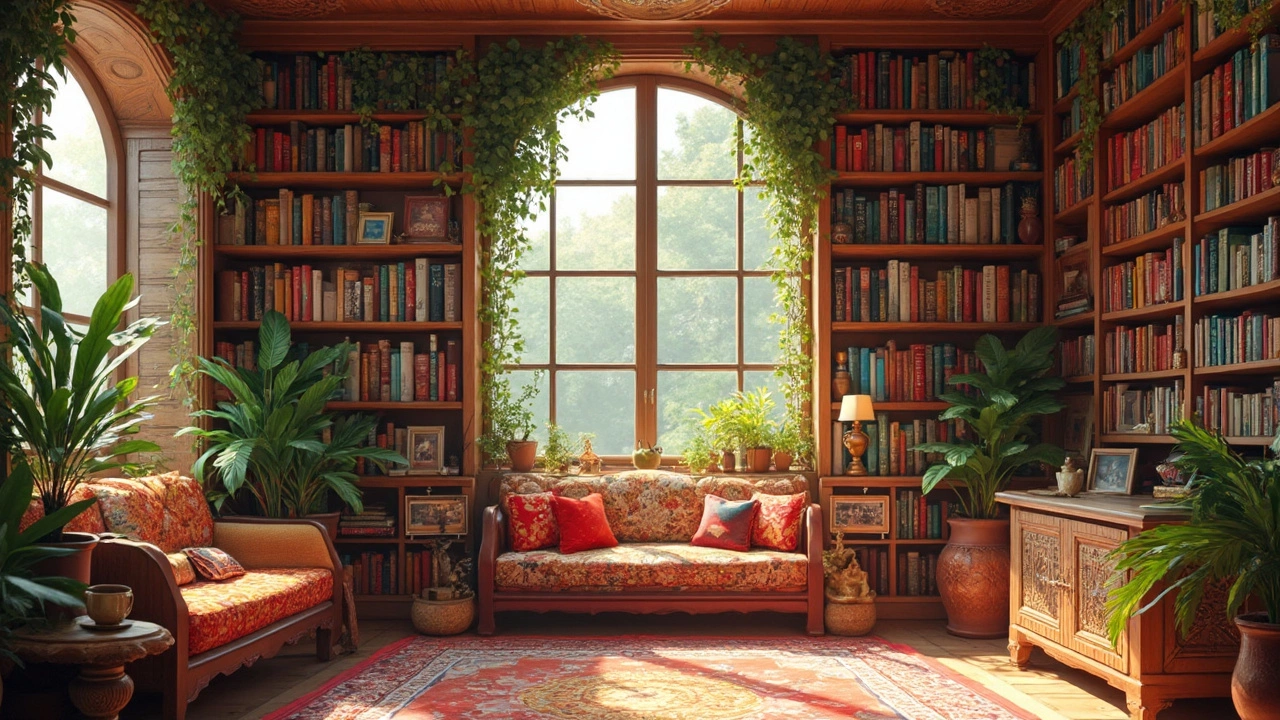Ever stare at your messy bookshelf and wonder why it doesn’t look anything like the ones in magazines? You’re not alone. The way you arrange those shelves changes the whole feel of your space, way beyond just giving your books a home.
First off, think about what you really need from your bookshelf. Are you housing a massive collection or just showing off a few favorites? The number of shelves, their depth, and the width matter—a lot. Go for adjustable shelves if you want the option to stash everything from fat cookbooks to skinny paperbacks. Tall shelves stretch a room, while shorter ones keep things casual and open up wall space for art or lamps.
Don’t just push all the books to one side or stack them randomly. There’s a simple trick: try mixing vertical rows with small horizontal stacks. This stops the shelf from looking overloaded and brings some order to the chaos. And here’s a game-changer: leave some breathing room. Not every inch needs to be packed; blank space actually draws attention to the cool stuff you do display.
- Choosing the Right Bookshelf
- Balancing Function and Style
- Arranging Books Like a Pro
- Mixing Books With Decor Items
- Using Colors and Textures
- Common Mistakes to Avoid
Choosing the Right Bookshelf
Picking a bookshelf isn’t just about finding one that fits your wall. It comes down to function, style, and the space you’re working with. Start by measuring the area where you want to put your bookcase. Skip the guesswork—grab a tape measure so you don’t end up with something too big or too dinky for the spot.
If you have low ceilings, try shorter or horizontal units. For apartment dwellers, wall-mounted shelves save floor space and look sharp above desks or sofas. Got tons of stuff? Go vertical. Tall units make small rooms look taller and let you squeeze in more storage for both books and extras.
The materials matter too. Solid wood holds up for years but is heavy. If you move a lot, go for lighter options like metal or composite boards. Particleboard bookcases are good on a budget but can sag if loaded down. Here’s a quick look at how different materials stack up:
| Material | Durability | Price Range | Ideal For |
|---|---|---|---|
| Solid Wood | High | $$$ | Permanent setups, classic style |
| Metal | Medium-High | $$ | Modern spaces, high traffic |
| Particleboard | Low-Medium | $ | Temporary use, light loads |
Don’t forget shelf depth. Most books fit on shelves 10-12 inches deep. Any deeper and you’re wasting room, unless you want to tuck in baskets or extra decor.
Open or closed? Glass doors help keep dust off, which makes sense if your book collection is super important to you. Open shelves look airier and make grabbing your favorite reads easier. If you want a less cluttered style, cabinets with doors are solid for hiding games, paperwork, or random chargers you never seem to need but can’t throw away.
Finally, check how much weight those shelves can handle, especially if you’re a hardback hoarder. Most standard shelves hold around 20-40 pounds, but always double-check if you plan to pack them with heavy art books or chunky novels.
Balancing Function and Style
Nailing the right balance with your bookcases is about more than just fitting in as many books as you can. If you go all-in on storage, you end up with a wall that feels heavy and cluttered. On the flip side, focus only on looks, and the shelf starts feeling staged—like no one ever reads those books. It’s not about choosing one over the other; the best shelves work hard and look good doing it.
Start by making sure every item on your bookshelf has a clear purpose. Books you reach for a lot? Keep them at arm’s height. Rare collector’s editions or big coffee table volumes? Those can live on the top or bottom shelves. Reserve hard-to-reach spots for stuff you don’t grab every day.
If you want things to stay usable, don’t block the books with too many decorations. The National Association of Productivity & Organizing Professionals suggests,
“On functional shelves, group items in threes and leave at least 20% of each shelf empty to avoid visual overload.”That means resist the urge to fill every gap. An easy way to do this: place a small stack of books horizontally, top it with a plant or framed photo, then stagger the height by leaving some space next to the stack.
For a quick cheat sheet on mixing style and function, try:
- Alternating books and decorative items, like a row of novels followed by a ceramic bowl or small sculpture.
- Storing larger, less-used items on the bottom for stability (think baskets or board games).
- Leaving a few vertical spots blank for breathing room—it makes the shelf look deliberate, not jammed-up.
Studies from the American Institute of Architects show that rooms with thoughtfully arranged bookcases feel more inviting and encourage people to hang out longer. So it’s not just about showing off your collection—it’s about making the space work for real life, while looking like you actually live there.
Arranging Books Like a Pro
If you want your bookshelves to look pulled together instead of random, there’s a simple formula: balance, grouping, and variety. Most interior designers agree that mixing up the way you stack and line up your books instantly makes your bookcases more interesting. Vertical rows work well for the bulk of your collection, but don’t be afraid to break it up by stacking a few books horizontally. This trick not only makes things look more relaxed but also helps fill awkward gaps between tall or short books.
Try these steps:
- Mix vertical and horizontal stacks on each shelf. Place some books upright side-by-side, and others flat in piles.
- Limit large clumps of books to about 60-70% of the shelf’s length. Use the remaining space for smaller objects or just empty air. That negative space keeps everything from looking crammed.
- Think about book height and color: line up books by height for a neat look, or deliberately mix them for a casual vibe. Want something punchy? Arrange by color (the classic rainbow order always catches the eye).
- Use bookends not just for holding books, but for breaking up the line. You can even stand up a plant or a small sculpture as a bookend.
Hardcover books hold shape better than paperbacks when standing tall. But if your collection is mostly paperbacks, try stacking them so the spines face out—you’ll still see the titles, and the shelf won’t look like it’s sagging.
If you’re really going for a style boost, alternate rows: upright books on one shelf, horizontal and decorative objects on the next. This zig-zag rhythm keeps eyes moving and stops the shelf from looking stiff.
Fun fact: a 2023 survey by the National Association of Home Builders found that homeowners with neat, styled bookshelves reported feeling more relaxed in their living rooms—about 46% compared to just 31% who had cluttered, overstuffed shelves. A tidy bookshelf really does make a difference!

Mixing Books With Decor Items
If you want your bookcase to stand out, you can't just load it up with rows of books and call it a day. One of the most popular bookshelf rules in interior design is to mix in some decor items. This breaks up the line of spines and brings personality to your space.
Start by gathering a mix of items that actually mean something to you—framed photos, a funky vase, a candle, or even small potted plants. Personal stuff makes a bigger impact than random store-bought knick-knacks. When adding these objects, group them in odd numbers—designers swear by odd-number groupings for a more eye-catching setup.
- Stack a few books horizontally and add a plant or candle on top. This changes the height and keeps your display interesting.
- Use bookends that double as decor—think sculpted heads, stones, or even a quirky action figure.
- Mix textures. Combine glass, metal, wood, and fabric; it’s a simple way to make the shelf look layered and lived-in.
- Show off collections. Maybe it’s old cameras, little bowls, or souvenirs from travels—small stuff that tells a story.
- Mirror the colors from your room. If your rug is blue, drop a blue vase or artwork on the shelf for balance.
Don’t forget lighting—battery-powered LED puck lights or tiny string lights tucked on a shelf can add warmth and make everything pop. Remember that about 40% of designers say lighting is the secret weapon for making shelves look polished—sometimes it’s the difference between ‘meh’ and ‘wow.’
Here’s a quick way to check if you’ve gone overboard: step back and snap a photo on your phone. It’s way easier to spot too much clutter or not enough color that way. Keep tweaking until the vibe feels just right.
Using Colors and Textures
If your shelf looks boring, it probably needs a mix of colors and textures—this is where your bookshelf rules get fun. First, look at your book spines. You can sort them by color for a bold statement or keep them neutral if you want a calm vibe. Some folks even flip their books backward for a uniform beige look, but this trick is honestly not for everyone—it kills functionality if you actually want to find titles fast.
Here’s where things get interesting: mix in objects that add texture. Don’t just go for shiny picture frames. Try baskets, ceramic bowls, wooden boxes, or even a chunky candle. Accessories with different surfaces make your bookcases feel special, not like a store display. If you want an easy win, place a soft plant in a woven basket right next to some hardback books. That combo immediately brings life and warmth.
- Pick 2–3 accent colors from your room and echo them with book covers or decor items on the shelf. This ties the look together.
- Mix matte and glossy things. For example, a stack of glossy art books next to a matte ceramic vase.
- Add at least one item with a natural material—real or fake plants, woven baskets, or wood crafts work great.
If you don’t believe color choices matter, studies show people feel more relaxed in rooms where only two or three main colors repeat, rather than a wild rainbow. For interior design, this means picking a main background (like white, wood, or black shelves), and using color pops just in small objects and art. Too many colors crush the vibe.
One last thing: swap out items as the seasons change. Lighter decor in spring and deeper, cozier stuff in fall instantly keeps bookshelf styling fresh, with zero remodeling.
| Easy Ways to Add Texture | Materials |
|---|---|
| Baskets | Wicker, straw, rattan |
| Vases and Bowls | Ceramic, glass, clay |
| Photo Frames | Wood, metal, acrylic |
| Plants | Real/silk leaves, succulents |
| Textiles | Small folded blankets or cloth books |
Common Mistakes to Avoid
Even if you buy the best bookcases out there, a few classic mistakes can wreck your whole vibe. If you want your bookcase to look great and actually work for you, watch out for these slip-ups that people make all the time in interior design:
- Overstuffing shelves: Packing shelves from end to end isn’t just tiring to look at—it makes it hard to find what you need. Experts usually recommend filling only about 75-85% of each shelf so things can breathe.
- Ignoring the mix: When you just line up books without adding anything else, your bookshelves end up looking stiff. Throw in small plants, framed pictures, or decorative bowls to break up all the straight lines.
- Forgetting about weight: Stacking heavy books on the top shelf? Not a great idea. That can actually make the whole piece unstable and is a pain when you want to grab something. Keep heavier books closer to the bottom for stability.
- Bad lighting: Bookshelves tossed in a dark corner are easy to forget. If natural light doesn’t hit your bookcase, add a spotlight or clip-on lamp. According to a 2023 Houzz survey, 42% of homeowners said lighting made their bookshelves more of a focal point.
- Ignoring scale: Tiny trinkets on a giant shelf or oversized art on a small shelf make things look off-balance. Match the size of objects to the shelf space—medium items usually work best in groups of three.
| Mistake | Fix |
|---|---|
| Filling every inch | Leave 15-25% empty space per shelf |
| Mixing too many colors | Stick to 2-3 main colors or repeat an accent color for styling |
| No visual breaks | Add a few horizontal stacks or objects between books |
If you avoid these common bookshelf mistakes, your shelves will not only look way better, they’ll actually work better too. Keep things balanced: some books, some decor, a little empty space, and good lighting. Your bookshelves should help your room shine, not just hold stuff.

